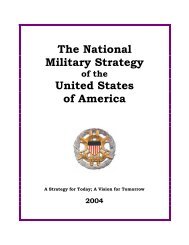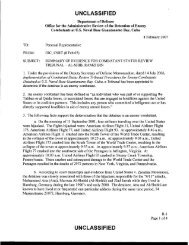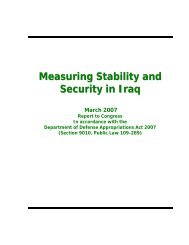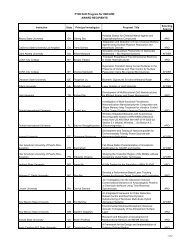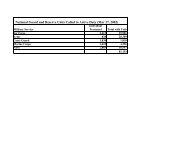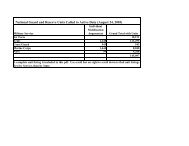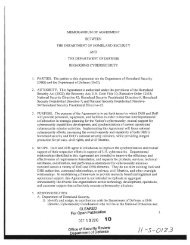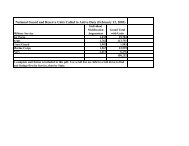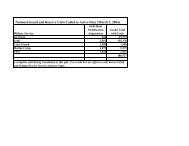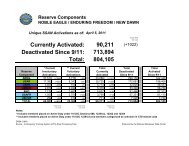Report - United States Department of Defense
Report - United States Department of Defense
Report - United States Department of Defense
You also want an ePaper? Increase the reach of your titles
YUMPU automatically turns print PDFs into web optimized ePapers that Google loves.
UNCLASSIFIED<br />
The pr<strong>of</strong>essionalization <strong>of</strong> the enlisted cadre is progressing from top-down. The curriculum <strong>of</strong><br />
the sergeants-major (SGM) academy has been endorsed, although the lack <strong>of</strong> suitably qualified<br />
instructors at the academy is causing concerns and may impact future courses. Post-2013, when<br />
fielding <strong>of</strong> the ANA is scheduled to be complete, the ANA plans to review the curricula for the<br />
NCO courses and (BWT. With respect to the BWT, the ANA have reduced their BWT course<br />
from nine to eight weeks. This course includes literacy training; the purpose <strong>of</strong> this which is to<br />
provide ANA soldiers with a level 3 literacy standard (read to learn) prior to further specialist<br />
training.<br />
As <strong>of</strong> March 2013, ANA NCO strength is at 82 percent <strong>of</strong> the NCO end strength objective.<br />
ANA <strong>of</strong>ficer strength is at 82 percent <strong>of</strong> the <strong>of</strong>ficer end strength objective. During this reporting<br />
period, a total <strong>of</strong> 10,811 <strong>of</strong>ficers, NCOs, and soldiers graduated from their respective courses at<br />
Officer Candidate School (OCS), the 1 Uniform Course (1U), and BWT. ANA Training and<br />
Education Command (ANATEC), the Afghan National <strong>Defense</strong> University (ANDU) and the<br />
ANA GSG7 are working on revisions <strong>of</strong> the current course system, Programs <strong>of</strong> Instruction<br />
(POIs), and future requirements for training and education beyond 2013. The main course focus<br />
is on literacy training, which should be provided before BWT as well as in the fielded units. A<br />
major new initiative in cultural awareness training about foreign and coalition force cultures was<br />
recently implemented to help mitigate the insider threat. In addition, training specific to this<br />
issue will also be developed and implemented within the ANA.<br />
The current challenges with ANA fielding stem from the specialized and technical nature <strong>of</strong> the<br />
units to be generated. The need to train technical soldiers, NCOs, and <strong>of</strong>ficers effectively and to<br />
bring them together to form an integrated and collectively coherent kandak impacts all aspects <strong>of</strong><br />
the recruiting, training, and fielding pipeline. The equipping <strong>of</strong> those units to field in this final<br />
stage <strong>of</strong> the fielding process will be a challenge.<br />
Special Operations Forces<br />
ANA Special Operations Forces (ANASOF) are the most capable component <strong>of</strong> ANSF and have<br />
made significant strides toward becoming an independent and effective force. This capability is<br />
reflected in their high operations numbers. From October 2012 to February 2013, ANSF SOF<br />
units led 86 percent <strong>of</strong> all special operations. In March 2013, ANSF SOF led 97 percent <strong>of</strong> all<br />
special operations.<br />
66



